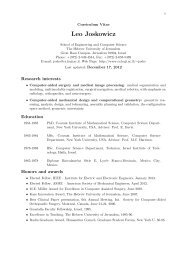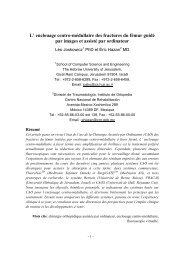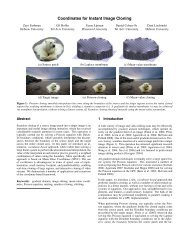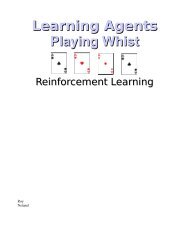TEL AVIV UNIVERSITY Gaddi Blumrosen
TEL AVIV UNIVERSITY Gaddi Blumrosen
TEL AVIV UNIVERSITY Gaddi Blumrosen
Create successful ePaper yourself
Turn your PDF publications into a flip-book with our unique Google optimized e-Paper software.
4.4.4 OSTBC with linear antenna weighting, based on only channel covariance<br />
feedback (ML sub-optimal)<br />
As we seen from previous chapters, the optimal weights are thus obtained by the<br />
conditioned value of the first two moments. If we assume, as in [31], the following<br />
scenario of no direct measurement of the channel is known to the transmitter, but only<br />
the channel covariance matrix, we can assume, in the case of the Rayleigh channel a<br />
zero mean value , m 0 , and no correlation between the channel covariance<br />
hh | ˆ<br />
approximation and its real value, R R .<br />
hh| hˆ<br />
Consequently, the solution can be substantially simplified, especially for the case of<br />
correlated channel coefficients. Note that although [31] does not use conditional<br />
covariance matrix (measure of CSI quality), it has shown that for this scenario of<br />
Gaussian channel with zero conditional channel mean value, same antenna weights<br />
are derived also for non perfect CSI.<br />
Using those relations and multiplying (4.14) by , we obtain:<br />
<br />
l( Z) log det I RhhZ (4.24)<br />
Let us further perform Singular Value decomposition (SVD) over the channel<br />
covariance matrix, , where is the unitary eigenvector matrix and<br />
is the corresponding square root eigenvalue matrix.<br />
<br />
<br />
H<br />
Rhh Uh DhU h<br />
h U<br />
D h<br />
Let us further define, as in [30], the diagonal matrix D as:<br />
2<br />
f<br />
<br />
D W U W U<br />
H<br />
T h T h<br />
(4.25)<br />
2<br />
As in [30], maximization of (4.24) force the matrices RhhZ and DD h f to be diagonal.<br />
Now, by substitution of Rhh Uh<br />
DhU h and Z WTWT<br />
into (4.24) and simple<br />
algebraic manipulation, relying on the symmetry of the matrices R and Z and the<br />
unitary of U , we obtain the same minimization expression as in [30]:<br />
h<br />
2 <br />
l( D f ) log det I DhD f <br />
hh<br />
H<br />
(4.26)<br />
Explicit expressions, for the k th beam obtained after power loading according to the<br />
power loading algorithm in [30] in the direction corresponding to the k th eigenvector,<br />
which minimizes (4.26), was found to be:<br />
H<br />
Wk D f Uk<br />
(4.27)<br />
The assumptions above, 0 and R <br />
R , make sense in fast fading<br />
mhh | ˆ <br />
hh| hˆ<br />
scenarios. Since both algorithms (in [25] and in [31]) minimize PEP, we expect the<br />
performance of the system of [25], and [31], to be the same in fast fading channel. In<br />
case of slow fading, if we have strong nonzero conditional channel mean value, as in<br />
Rician fading, we expect the solution in (4.14) to enhance the system performance.<br />
R hh<br />
hh<br />
f<br />
H<br />
hh








